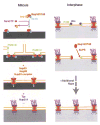Nuclear pore complexes: guardians of the nuclear genome
- PMID: 21502404
- PMCID: PMC3649117
- DOI: 10.1101/sqb.2010.75.059
Nuclear pore complexes: guardians of the nuclear genome
Abstract
Eukaryotic cell function depends on the physical separation of nucleoplasmic and cytoplasmic components by the nuclear envelope (NE). Molecular communication between the two compartments involves active, signal-mediated trafficking, a function that is exclusively performed by nuclear pore complexes (NPCs). The individual NPC components and the mechanisms that are involved in nuclear trafficking are well documented and have become textbook knowledge. However, in addition to their roles as nuclear gatekeepers, NPC components-nucleoporins-have been shown to have critical roles in chromatin organization and gene regulation. These findings have sparked new enthusiasm to study the roles of this multiprotein complex in nuclear organization and explore novel functions that in some cases appear to go beyond a role in transport. Here, we discuss our present view of NPC biogenesis, which is tightly linked to proper cell cycle progression and cell differentiation. In addition, we summarize new data suggesting that NPCs represent dynamic hubs for the integration of gene regulation and nuclear transport processes.
Figures



References
-
- Akhtar A, Gasser SM. The nuclear envelope and transcriptional control. Nat Rev Genet. 2007;8 (7):507–517. - PubMed
-
- Alber F, Dokudovskaya S, Veenhoff LM, Zhang W, Kipper J, Devos D, Suprapto A, Karni-Schmidt O, Williams R, Chait BT, et al. The molecular architecture of the nuclear pore complex. Nature. 2007;450(7170):695–701. - PubMed
-
- Anderson DJ, Hetzer MW. Nuclear envelope formation by chromatin-mediated reorganization of the endoplasmic reticulum. Nature cell biology. 2007;9(10):1160–1166. - PubMed
Publication types
MeSH terms
Grants and funding
LinkOut - more resources
Full Text Sources
Molecular Biology Databases
